Motorcycle trip in Lithuania
Numerous churches and a hill covered with crosses
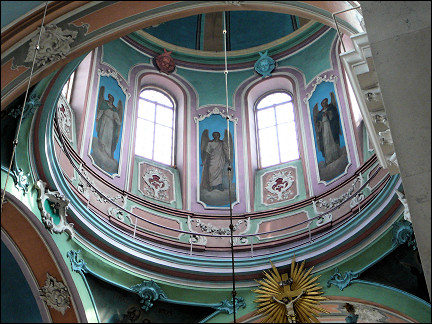
|
On a motorcycle to the Baltic state of Lithuania, through rolling hills along Trakai, where on an island in Lake Gatvé a big castle sits; the capital Vilnius, where in the center alone are already 30 churches with exuberant interiors, impressive cupolas and beautiful frescoes; a hill near Siauliai which is completely covered with crosses and Klaipeda, with a clock and a cast iron museum.
Travelogue & photos: Peter van Boheemen
We wake up in our tents in the Polish town of Augustow, ready for our Baltic adventure. We drive our motorbikes to a small supermarket where we get sandwiches. We haven't finished them yet before it starts to rain. Quickly we pack our stuff before it gets worse.
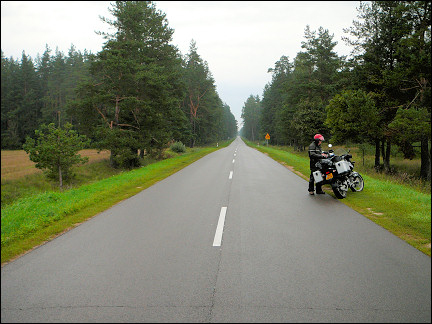
|
We drove almost non-stop for two days, but we covered a lot of distance, so it was worth it. The last 50 kilometers to the Lithuanian border are on a long straight road through a forest. Luckily there is a gas station on this deserted route.
The rain stops and we reach the border. An ID is sufficient these days. When I traveled to the then Soviet Union 14 years ago, it was quite different. One had to bring a visa with photo along with a passport. But Europe is growing and the amount of vacation destinations that can be traveled easily increases.
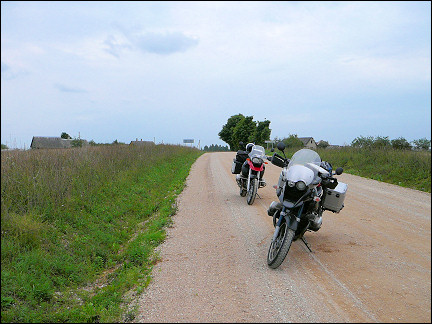
|
We cross the border without problems. We can't change money here, but our gas tanks are full, so that is not a problem. The roads are excellent. The European Union invests a lot of money in the new member states and signs on the new roads tell us so.
Trakai
On an island in Lake Gatvé sits a big castle
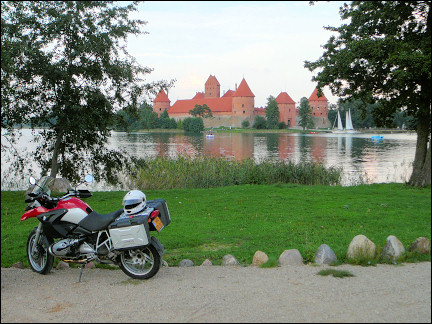
|
Near Alytus we ride along huge fields in a rolling landscape. We're going in the direction of Vilnius. I know that in Trakai, about 30 kilometers west of Vilnius, is a camping site. We find it after riding on an unpaved road for a while.
The camping site is situated beautifully on Lake Gatvé. A nice girl welcomes us. Her English is better than mine. She answers my question "Can I take here money from the wall?" (which is literally translated from Dutch, Ed.) correctly with: "Yes, there's a cash machine."
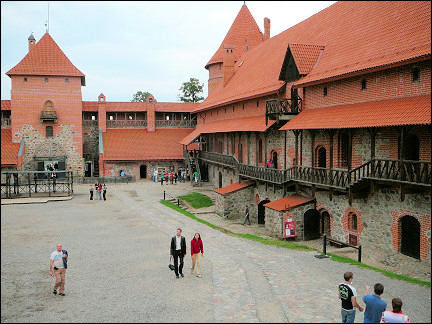
|
She also arranges for a boat to pick us up and take us to the center of Trakai. There we're let off at the island castle.
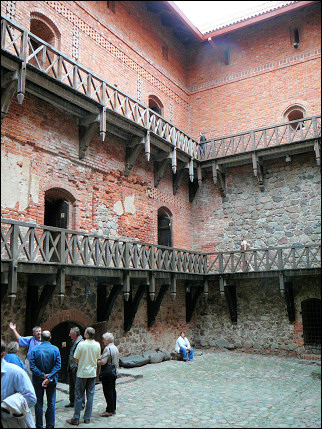
|
The castle is a reminder that Trakai is one of the oldest cities in Lithuania. Ironically, even as the castle was completely destroyed in the 17th century during a war with Russia, those same Russians helped restore the castle in the 1950s.
First we have to find an ATM. That turns out to be no problem at all in Lithuania. With our wallets full of Lithuanian Litas we explore the town. We're lucky: there's an oldtimer afficionados gathering with many antique cars and motorcycles, mainly Eastern European, and they are in great condition.
We eat a snack on the boulevard and then visit the castle. There are tens of bridal couples for photo sessions at the historical castle.
We buy tickets to get inside. Via the pretty courtyard we enter the historical museum which is housed in the castle. The exhibits are old maps, pottery, clothes, furniture and jewelry.
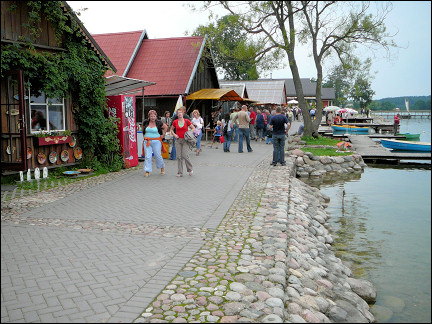
|
There are many bars and restaurants in Trakai. We have a nice meal of pork. We walk back to the camping site. In the cafeteria a private party is going on, so we go to bed early.
Vilnius
Churches with exuberant interiors, cupolas and frescoes
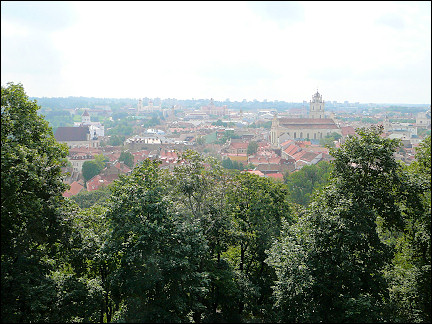
|
It rained tonight, but this morning it's dry. We make coffee and get ready to visit Vilnius.
Once there, it isn't easy to find the city center. There are hardly any signs. I ask a bus driver. If he doesn't know... But he does and we find it quickly. There even is a guarded parking lot. Nice: during the whole day our bikes are guarded for an amount of money for which you wouldn't be able to park for even an hour in The Netherlands.
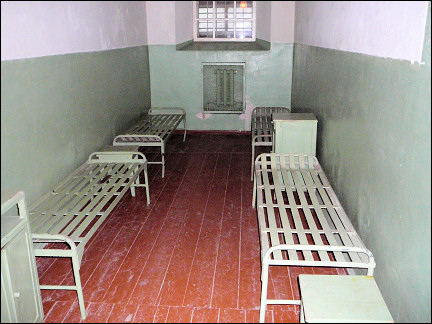
|
After a cup of coffee we walk to the bell tower. Bad luck: the tower is scaffolded. But we're also lucky: the sun breaks through the clouds and warms up the city.
First we visit the museum for victims of genocide which is housed in the former KGB prison. The cells are still in their original state and look as if they have just been vacated. Lugubrous is the torture room which is insulated, so the screaming wouldn't be heard. There is a radio room with sounds and a library.
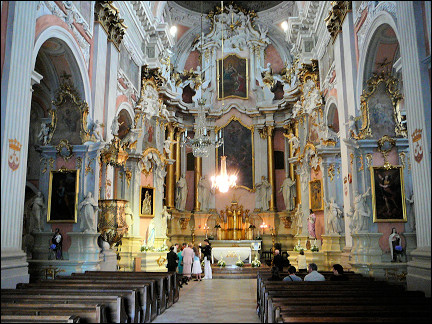
|
A literal high point is Gedima Hill. The steep, cobble-stoned path leads us to the castle on the hill. There is a great view of the city center and the Neris River.
Down again, we walk to the Pilles, the most important shopping street of Vilnius. Remarable is that the city center has free wireless internet access everywhere. Lap top on your lap and surf! What do you mean backward Soviet state? But we didn't bring a lap top and limit ourselves to a few text messages home.
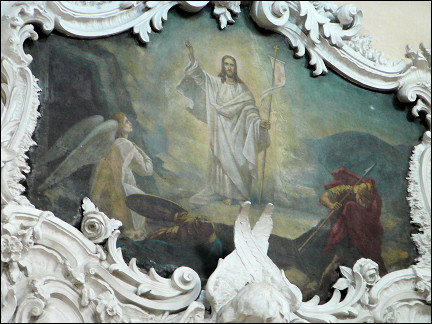
|
But Vilnius is mainly a city of churches. Many of those are stunning. Only in the center there are already 30 of them. Obviously, that is a little bit too much of a good thing, whether you're religious or not.
We visit some beautiful and/or remarkable sanctuaries, like the Holy Spirit church, the Anna church and the St. Theresa church. They all have exuberant interiors, impressive cupolas and beautiful frescoes.

|
The Gate of Dawn is not to be missed. It is the only remaining defense gate of the five the city originally had. Inside the gate, the Carmelites built a chapel for a Madonna painting in 1671. The icon is covered with gold. There are people praying in the chapel and they seem hypnotized by the painting.
The chapel has a nice view of the authentic street that leads to the city center.
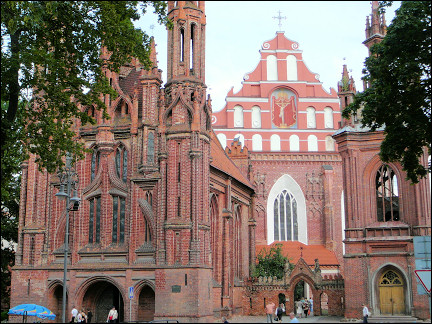
|
We end our church tour at the cathedral near the bell tower. This morning there was a service, but now we can look around as much as we want. That was our day in Vilnius. We saw a beautiful, authentic city which undoubtably has a great future for tourism.
We go fetch our motorbikes. The guard doesn't have change, so we have to get back into the city.
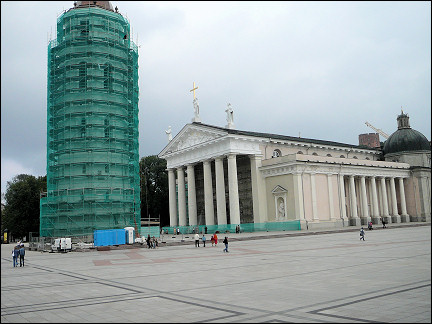
|
We ride back to Trakai. We have dinner in the same restaurant as yesterday. The language makes communication complicated. We order a double-sized portion of something and instead we get two stuffed pastries. The waitress wants to know if we drink our coffee black: she points to my black motor jacket.
Back on the camping site we're no longer alone. A group of Dutch trailers with retired owners has arrived. We drink a can of beer in front of the tent and then go to bed.
The hill with crosses near Siauliai
Hundreds of thousands of crosses are crammed together
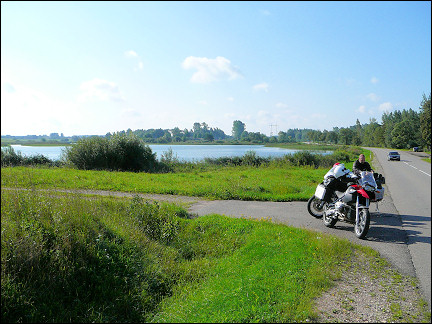
|
It's a bright morning. Breakfast and pack. The first part of today's route is very pretty. We ride in a rolling landscape between lakes. It looks vast, with only a few lonely trees. Later the landscape gets monotonous and it gets colder and overcast.
We ride toward Siauliai. A little to the north of this city is the hill with crosses, probably one of the most remarkable sights of Lithuania.
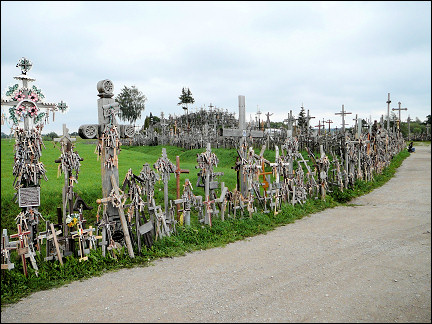
|
On a small hill, hundreds of thousands of crosses are crammed together. They are brought here by many pilgrims who, following the example of the pope in 1993, come here to place yet another cross.
Sometime to memorize a family member, but mostly as a symbol of resistance, for which the hill originally was meant.
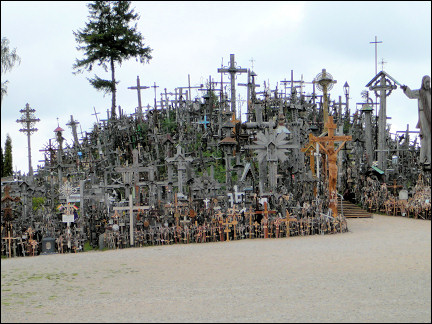
|
We walk over the hill and are amazed at the enormous amount of crosses, standing next to and on top of each other, or leaning against one another. On the bigger crosses hang smaller ones. Sometimes the crosses are old and decrepit, rusty or rotting. Other crosses look modern and are made of stainless steel.
According to legend, the tradition of placing crosses on this hill goes back to the 14th century. There may have been a Lithuanian fortress in this place. The population placed crosses near it to memorialize the successful battle against German knights. Later, in the 19th century, it developed into a symbol of national resistance.
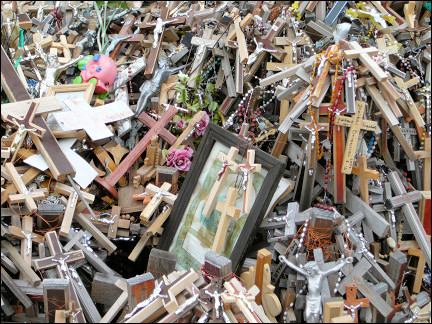
|
During the Soviet dictatorship crosses were placed to remember people who were sent to Siberia and never heard of again. This of course did not amuse the communist leaders, who had the hill bulldozed three times.
After the fall of communism the hill developed into what it is now.
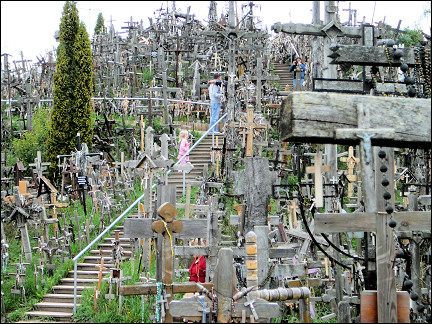
|
After we have seen the hill from all sides and have visited the little church, we get on our motorbikes and ride in the directon of the Baltic Sea. The sky looks threatening and yes, there is the first shower. It doesn't last long, but more follow.
When we arrive in Klaipeda, large puddles of rainwater prove that we've missed the worst part of the rain. According to the map there should be a camping site here. But we can't find it. While we're waiting at a railroad crossing, a German-speaking Lithuanian asks about our plans. When he hears we're looking for a camping site, he tells us we can pitch our tents on his land. I'm not sure it is an official camping site, but there are trailers and there is a hot shower. Who cares anyway, we have a place for our tents. There is also a small supermarket with beer on draught.
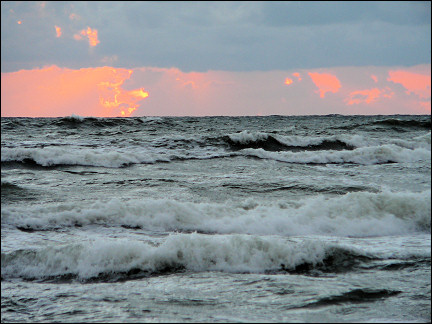
|
In the evening we walk to the beach. There is a good and atmospheric restaurant which serves pork chops. Lithuania has good meat and beer.
Klaipeda
From kitschy cuckoo clock to pocket watch and sun dial
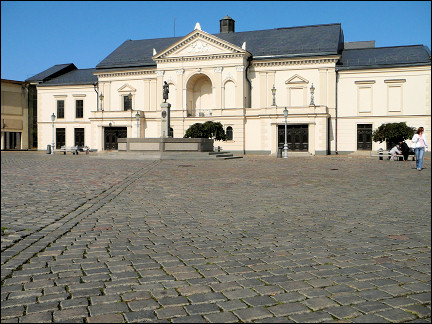
|
We are 14 kilometers from Klaipeda. A little too far to walk, so we take the motorbikes. It's hard again to find the city center. In a gas station I buy a map, which leads us to the center. We park our motorbikes on the square in front of the theatre.
On the square are many souvenir stalls which sell amber, sometimes set in jewelry. They are not used to tourists yet. When I say "It's fake," the saleswoman seriously answers: "Yes, yes."
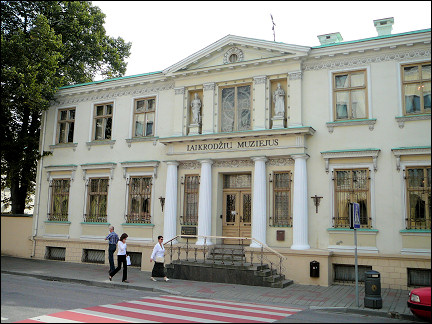
|
The classicist theatre on the square has a history. In 1939 Hitler declared the annexation of Klaipeda, then called Memel.
Our next destination is the clock museum. It takes us a while to find it. We walk past it without noticing. "Muziejos" means museum in Lithuanian and has nothing to do with music, that was our mistake.
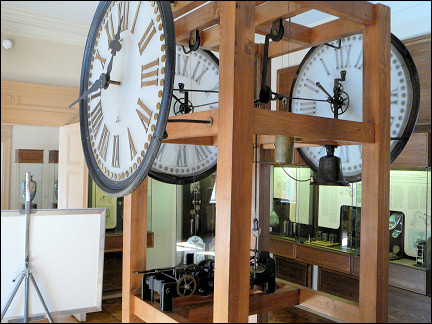
|
The monumental building is worth a visit. It exhibits many antique clocks: from kitschy cuckoo clocks to beautiful pocket watches and clockworks that are used in church towers.
The technical explanation of the technology is only in Lithuanian and Russian, so that doesn't really help us. The museum also has a garden with - no surprise - a sun dial.
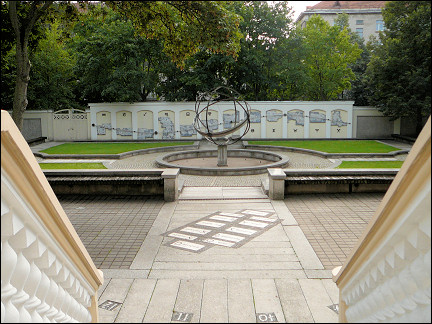
|
We take a walk in the sculpture garden. It is not very interesting, but its history is. There was a German cemetary here, but in 1975 it was bulldozed by the Russians.
What remains of it is exhibited in the cast iron museum, which has old black and white pictures of the cemetary and lots of old cast iron that was saved from underneath the bulldozers.
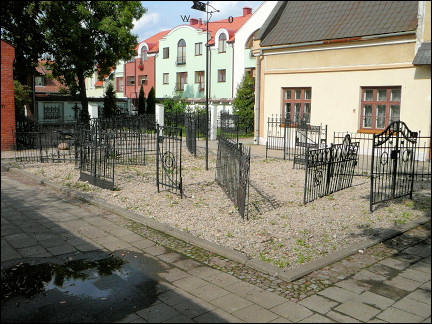
|
What hasn't changed since the Soviet days in Lithuania are the museum attendants. Often they are elderly women who just stare ahead of them all day long, guarding the valuables and giving directions to visitors.
After lunch we happen upon the last museum for today. It's the historical museum. It has everything from prehistoric objects to traditional garb. The old maps that show how often the borders have changed are the most interesting part of the exhibition.
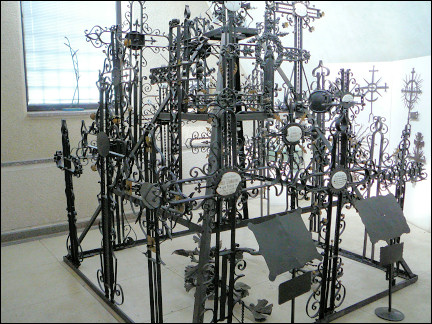
|
After that we've seen enough of Klaipeda and we ride back to our tents. In the late afternoon sun I enjoy sitting in an outdoor café and observing village life. Construction workers have a beer here after work, but bicycling families sit down as well for a break.
Back to Poland
Pretty green, lakes, nice villages and towns
I ask the owner of the camping site, of which I still don't know if it's an official one, what we have to pay him. He doesn't know. Well, I don't either. "Never mind," he says, "It's free." Isn't that nice?
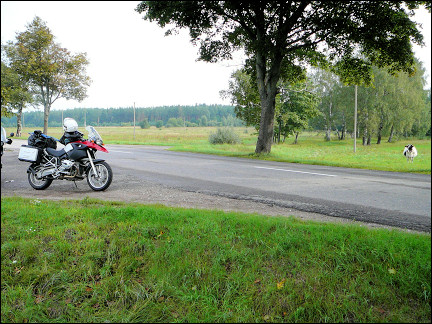
|
We have to find our way out of Klaipeda. Because of the lack of proper signs, that could be hard. But we're lucky. I have guessed the right direction and after a lot of busy traffic, we get exactly where we want to be.
Road # 141 to Kanaus is our route for today. The first part reminds us of Dutch polders. Including the black and white cows. For the rest of the day, the landscape is typically Lithuanian. Pretty green, lakes, nice villages and towns. Smooth asphalted roads, but also somewhat monotonous. Also along the Nemunas river: beautiful views of the river, but a little monotonous.
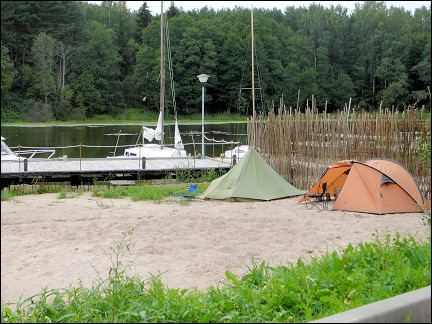
|
Near Kanaus we look everywhere for a camping site. But as much as we ride around, we can't find one. So we camp on a sand beach near a motel on a big lake. In the evening there's entertainment: the bar is open late.
It starts to rain. And it continues. Also when we wake up the next morning. What should we do? We would like to see picturesque Kanaus and in Rumsiskis is an open air museum. But the rain doesn't stop. And the motel is closed: no water, let alone a shower.
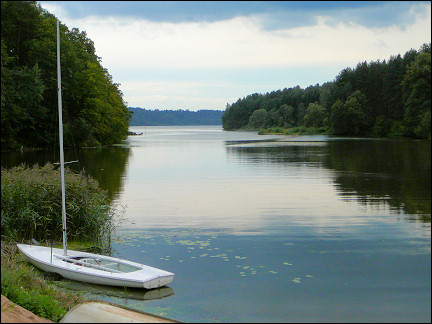
|
On my cell phone I get the weather forecast for Poland. It's dry there. And because the ride back home is long, we're increasingly tempted to leave Lithuania. And so we do.
Despite the rain it's a gorgeous route. The old wooden houses in the vast landscape look lovely. But I can't imagine to have to live through a harsh and cold Lithuaniane winter in one of these houses.
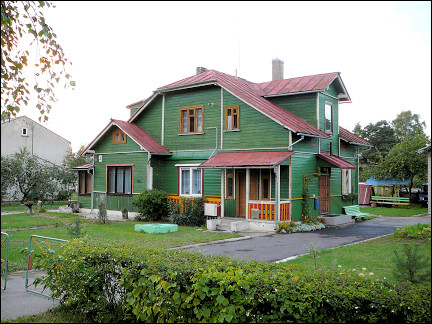
|
We have coffee and brush our teeth at a gas station. After Marijampolé we ride to the Polish border. In Poland it's dry indeed.
Lithuania has made a favorable impression on me. The country seems more developed than Poland which we'll cross in the coming days. I have no doubt that it will be developed more soon. Maybe too soon. In any case: we have seen the authentic Lithuania.